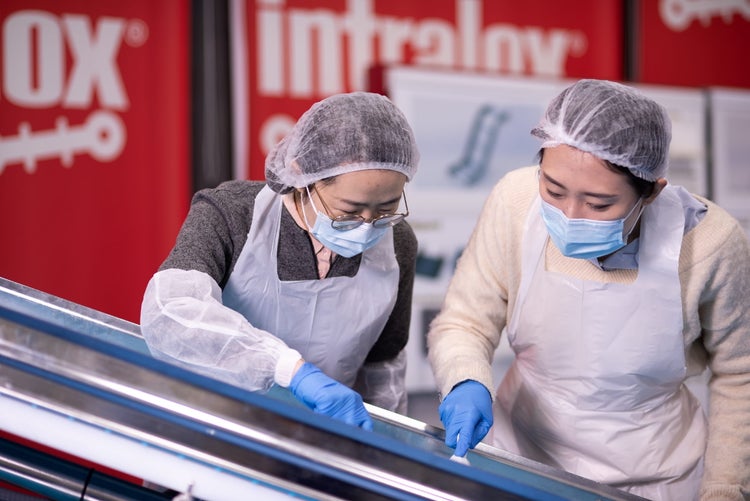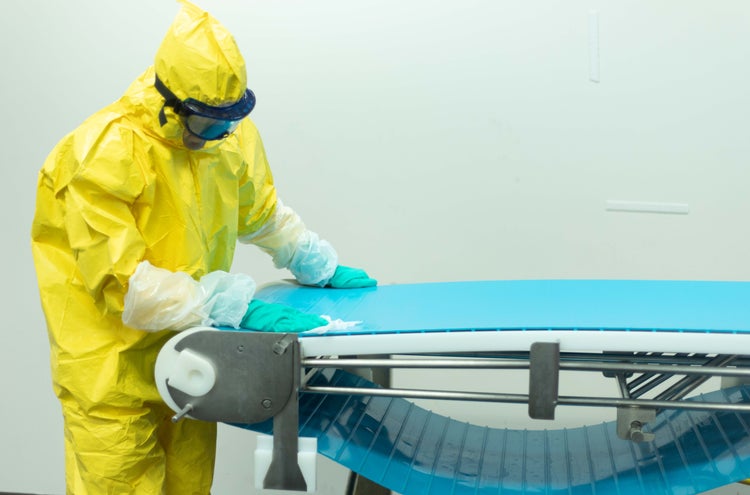Wet vs Dry Cleaning (Part two)

In my last column, I commented on the challenge of cleaning in the baking industry. Simply put, there is a war on water that focuses heavily on, unless absolutely necessary, reducing or stopping its use for cleaning in dry facilities. The use or presence of water is a significant risk for Salmonella growth and cross-contamination. If present, water allows for pathogen growth and is an excellent and efficient way to spread them throughout a facility.
The war on water focuses on eliminating it in sensitive dry and potential risk areas that contribute to a wet environment such as roof leaks, leaking valves/pipes, condensation or aerosols from the use of water hoses in adjacent areas.
Here are several scenarios of dry cleaning and sanitizing approaches along with what is known as a combination method of cleaning — using wet and dry techniques while providing minimal water or moisture for microbial growth.
Dry sanitizing can vary based on different areas of a plant.
For dry cleaning, plants can use vacuum cleaning with Hepa air filtration on the air discharge side, scrapers, brushes to collect soil and dust, dry floor push mops, a food contact alcohol-based sanitizer, alcohol to provide lubricity to collect soil with a wiper, dry or low-moisture steam, pelletized CO2 blasting, and sodium bicarbonate blasting.
Dry sanitizing can vary based on different areas of a plant. For food contact surfaces, or Zone 1 areas according to the Food Safety Modernization Act, dry sanitizers can be used following the dry-cleaning techniques mentioned above. The best approach is to use a high-percentage isopropyl alcohol (IPA), about 60%, and quaternary ammonia sanitizer. IPA helps drive off moisture, if present, and can be applied on a wiper or with dispensing equipment where it is propelled by CO2.
For Zones 2-4 — everything from equipment next to food contact surfaces to outside the factory — there are several options. For floor controls that provide pathogen control in dry ready-to-eat (R.-T.-E.) areas, I recommend the use of alkaline peroxide dry powder for application in trouble spots or transition areas where a “hurdle” is needed. Effective formulations include a high percentage of percarbonate in the 90% range. The American Meat Institute sponsored a study years ago that showed percarbonate more effective than powered quaternary ammonia compounds.
To clean a conveyance belt for the removal of allergens without the use of water, dry clean the belt with scraper and vacuum. Then apply an alcohol-based contact surface sanitizer with a spray or on a wiper for lubricity to easily remove soil. Following the cleaning procedure, use a residual protein, allergen or lateral flow test kit to verify effectiveness and provide ongoing surveillance to ensure its effectiveness. Repeat with the same chemical for sanitization.
To dry clean and sanitize a Zone 3 area such as a floor after a positive test for Salmonella, scrape and vacuum the specific site and surrounding area, apply a liquid alcohol-based sanitizer followed by an application of alkaline peroxide powder to the general area. Then retest.
Bakers must know when to use either one or a combination of both for sanitary operations.
A combination clean might be needed for special circumstances on product contact surfaces to remove soils. Such cleaning may include previous dry steps, then a limited use of water or dry steam with a detergent followed by a rinse and an alcohol-based sanitizer. Whenever water is applied to product contact surfaces in dry facilities, ensure that the areas cleaned and sanitized are moisture-free before production commences.
Another potential combination clean could be to disassemble the equipment, transport it to an enclosed room where it could be wet-cleaned in a clean-out-of-place tank or an automated washing system. This is often done when cleaning weigh scales. Once clean and dry, these parts can be returned via a clean dry cart where the equipment can be sanitized and reassembled.
A conveyance belt for a dry product sprayed with oil after the oven can be cleaned with a combination method. Dry clean the belt with scraper and vacuum first. Then, using warm to hot water with a detergent in a bucket, use wipers dipped into the solution to loosen soils and oily films on the product contact surface. Once soils are removed, the belt should be rinsed with clean water in a bucket and a clean wiper. The key is that no hoses should be used in this situation. This should be followed by an alcohol sanitizer similar to the dry step above.
Although I referenced pelletized CO2 and sodium bicarbonate as dry tools, these are not typically used for routine cleaning.
These are general examples. More details are needed for acceptable execution and should be detailed in a sanitation standard operating procedure specific to each situation.




